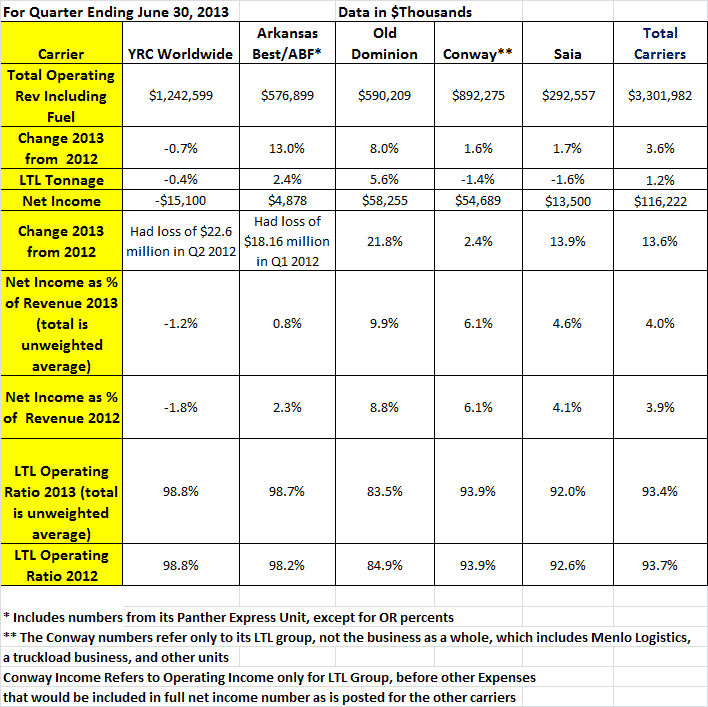From SCDigest's On-Target E-Magazine
- Aug. 13, 2013 -
Logistics News: Dark Days for Less-than-Truckload Carriers Appear to Really Over
Profitability Continues to Grow, as Operating Ratios Fall; Old Dominion Continues to Impress
SCDigest Editorial Staff
The less-than-truckload (LTL) sector in the US has been challenged financially for decades, and was hit especially hard when the recession started in 2008 and for several years afterwards, highlighted by the near-death experience of YRC Worldwide.
SCDigest Says: |
 |
| In general, the LTL carriers continue to stress similar themes: network optimization, a focus on yield management, eschewing "bad freight," and other steps to improve profits even in at the expense of lower volumes. |
|
What Do You Say?
|
|
|
|
But it does seem of late that the LTL group has really turned the corner, as evidenced by our usual review of the results in Q2 and the first half of 2013 for the five publicly traded LTL carriers we follow. (That group does not include the major LTL operations of FedEx and UPS, which do not break out their numbers for LTL in a way we can use in the analysis).
This is the last in our three quarterly review and comments across US transportation modes, following similar efforts for truckload carriers (see Mixed Q2 for US Truckload Carriers, as Evolution Continues for Many) and prior to that the rail carriers (see Union Pacific Separates Itself from the Pack in Q2).
That reviews includes tables of financial and operating results for both Q2 and the first half, and then later highlights of management comments in their Q2 earnings releases, though as usual the LTL group offers less insight on industry trends and company performance than do most of the truckload and rail carriers.
From an overall industry perspective, the American Trucking Associations said trucking volumes (including LTL) were up 4.3% in April year-over-year, 6.5% in May and 5.9% in June, but as with the truckload carriers, most of the LTL providers characterized volumes as lackluster. Average tonnage changes across the group were just a +1.2%. We are not sure how to reconcile the differences between the ATA's numbers and what the carriers are reporting.
Those modest volumes make the LTL sector's profit performance even more impressive. Four of the five carriers in the group were in the black in Q2, and the one that wasn't - YRC - made an operating profit and trimmed its overall loss to just $15 million on $1.2 billion in revenue.
Overall revenue growth for the group was 3.6%.
As usual, Old Dominion led the way, sporting revenue growth of 8%, tonnage growth of 5.6%, and profit growth of 21.8%, as its performance continues to impress quarter after quarter.
Overall, total sector profitability was up 13%, a solid performance given the weak rise in total tonnage.
Saia and Conway Freight appear to be learning some lessons from Old Dominion, with solid quarters in terms of profits. All told, the five carriers drove their operating ratios (operating expense divided by operating revenues, a key financial measure in the transportation industry) down to the low 90s, improving from 93.7% in 2012 to 93.4% this year.
Of course, Old Dominion again led the way, seeing its OR fall to an amazing 83.5%, versus that group average (including Old Dominion's number) of 93.4%. If you strip out Old Dominion, the average rises to 95.8%, meaning Old Dominion operates at an incredible more than 10-point advantage over its rivals.
But as is happening with increasing regularity of late, all five LTL carriers saw operating ratios of under 100, after several years where this was never the case.
By way of comparison, that LTL OR average of 93.4% in Q2 compares to a group average of 87.9% for the truckload carriers in Q2. The LTL best of 83.5% for Old Dominion compares to a TL best of 78.1% for Heartland Express.
In general, the LTL carriers continue to stress similar themes: network optimization, a focus on yield management, eschewing "bad freight," and other steps to improve profits even in at the expense of lower volumes.
LTL Carrier Q2 2013 Results

(Transportation Management Article Continued Below)
|